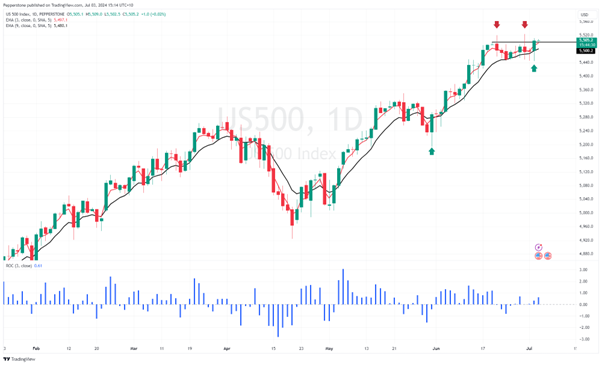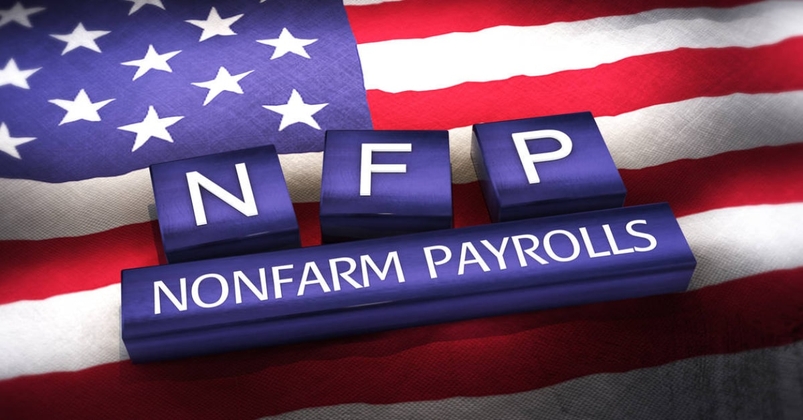- English (UK)
Big levels tested for the US500 and NAS100 – where to from here?

Well, obviously no one knows, but when we consider the future direction by way of probabilities, I would argue the path of least resistance in the near term is higher - albeit with volatility so low, it will likely be a grind higher than something more explosive.
From a pure fundamental standpoint, the level for me to really look at short positions with higher conviction is 5700 – if the US500 can get there, without broad earnings upgrades, then this is where things get really stretched and the low tolerance for any negative news will resonate with increased daily selloffs.

The playbook
Technically, a convincing closing break above 20,080 for the NAS100 and 5520 in the US500 would get the party started again and squeeze further juice out of this bull market. Buying into strength may seem a bizarre concept to some, but not to those who subscribe to the theory that a body in motion, stays in motion.
Should the price roll over, however, and head through 5445, I would strongly reassess that bullish stance, especially if the VIX index were to rise above 14%.
Running a systematic stop, such as a simple 3-EMA and 8-EMA crossover would work too - so if the index does kick higher, then I would stay long and unemotional until these rules dictated an exit. Simple trading, but it works well in trending conditions.
The bull case
- On Tuesday, the US500 printed a bullish daily reversal – in the past 2 years, when we’ve seen this type of price action in 90% of occurrences the market saw follow-through buying.
- July is a speculator month to be long both the NAS100 and US500 – the NAS100 hasn’t closed lower in the month of July since 2007.
- US Q2 earnings season commences on 12 July, and while expectations are certainly elevated, and company guidance will need to deliver in spades, the prospect of a further melt-up into earnings remains a real possibility.
- S&P500 20-day realised volatility sits at a YTD low of 6.7% - so, while we are seeing early signs of a deterioration in consumption in the US until the US data really ramps up the probability of a future recession, traders will keep selling volatility and this will help equity momentum to push further higher.
- The ‘Fed put’ is firmly in play – Fed Chair Jay Powell made that clear yesterday when he acknowledged that he would not be happy to see a further increase in the unemployment rate and that a weaker labour market from here could bring the Fed into play. Why sell equity when the Fed has your back?
- The market’s ‘Generals’ – Apple, Microsoft, Google, and Amazon – all currently see solid underlying bullish momentum, so unless we hear new news that causes these behemoths to reverse, then pullbacks in these names will likely be well supported. We also see US financials coming to the party, with JPM and BAC hitting new highs, and names like MS and Goldman’s also looking like they could see further upside potential. Nvidia consolidates, but finds bids below $120, so if that level can hold then the broad index can still work.
- The market senses that a Trump 2.0 as President will be an equity positive. The potential for deregulation, as well as increased deficits through tax cut extensions in 2025, is a bullish kicker.
The risks to consider:
- Valuation – not typically a factor that short-term traders really worry about – but the US500 trades on an elevated 22.8x forward earnings – so unless we hold the conviction that we’re due an earnings upgrade cycle in the coming weeks then I wouldn’t expect the market to want to pay more than 23x, maybe 24x for expected S&P500 earnings. With S&P500 forward EPS assumed to hit $241.48, this really puts 5700 as my peak price target – at least from a purely valuation perspective.
- Rich positioning – We can look at systematic trend-following funds (CTA’s), volatility targeting funds (pension and insurance funds), or various investment bank investor surveys – they all highlight that many have gone all-in, and a lot of money has been invested into a concentrated position.
- Poor market breadth – we see an ever-increasing number of charts passed around about the increasing influence of a handful of mega-caps. One that jumped out was that the top 10 companies (by market cap) in the S&P500 now account for a record 37% of the total market cap of the S&P500.
We can go on with many more considerations and variables to add to both the bullish and bearish arguments – however, as always, sentiment and flow are what move price in the short term, and often the market will simply go to where it wants to go.
Be a slave to price action and consider the probabilities for future direction. This week’s US payrolls may be a risk, just as it might be a positive catalyst – but I have a playbook and quasi-plan of attack and remain vigilant to effectively manage risk.
Related articles
The material provided here has not been prepared in accordance with legal requirements designed to promote the independence of investment research and as such is considered to be a marketing communication. Whilst it is not subject to any prohibition on dealing ahead of the dissemination of investment research we will not seek to take any advantage before providing it to our clients.
Pepperstone doesn’t represent that the material provided here is accurate, current or complete, and therefore shouldn’t be relied upon as such. The information, whether from a third party or not, isn’t to be considered as a recommendation; or an offer to buy or sell; or the solicitation of an offer to buy or sell any security, financial product or instrument; or to participate in any particular trading strategy. It does not take into account readers’ financial situation or investment objectives. We advise any readers of this content to seek their own advice. Without the approval of Pepperstone, reproduction or redistribution of this information isn’t permitted.

